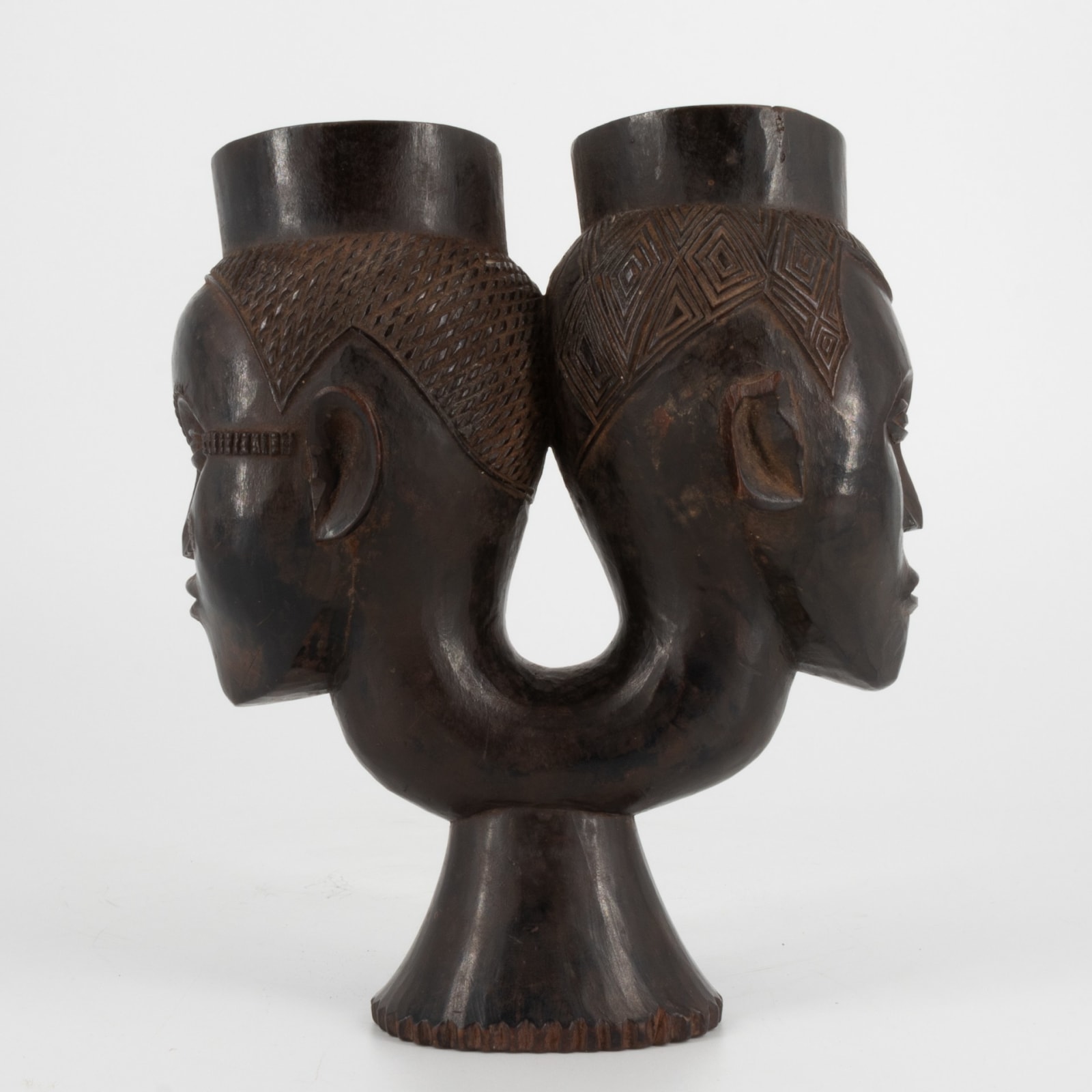Kuba Palm Wine Cup, 20th century CE
Wood
height 18.2 cm
height 7 1/8 in
height 7 1/8 in
ES.8765
The Kuba Kingdom, also known as the Kingdom of the Bakuba, is a conglomerate of several smaller chiefdoms which was formed in the 17th century in the centre of what...
The Kuba Kingdom, also known as the Kingdom of the Bakuba, is a conglomerate of several smaller chiefdoms which was formed in the 17th century in the centre of what is now the Democratic Republic of the Congo. It reached its peak during the 19th century, before the arrival of Europeans to the area (although it still exists today). It was founded in 1625 by Shyaam a-Mbul a Ngoong, who came from outside the area and united several principalities under his leadership. The government was controlled by a king (nyim) who attended a court council with representatives from all of the Kuba subgroups. As well as elected political offices, the kingdom also had a judicial system, taxation, a police force, and a military. It gained wealth through the adoption of advanced techniques from neighbouring peoples, as well as the cultivation of New World crops such as maize and tobacco. The wealth of the kingdom allowed for the development of a distinctive artistic tradition because of the desire of the elites to commission artworks that could display their power. Types of objects frequently seen include embroidered raffia textiles, headdresses, masks, ndop (sculptures representing Kuba kings), cosmetic boxes, and carved palm wine drinking cups. Palm wine, made from the sap of palm trees, is a popular beverage among the Kuba people. Highly decorated vessels became common as a way for elite individuals to compete with each other, as offering wine to friends in an impressive cup was a way of showing their wealth and status.
This double cup takes the form of two human heads. Above a conical base, the same curved section of neck supports both heads, which are touching at the back. Each head is individually hollowed out, and the hollows are connected by a small hole where they touch at the back, allowing liquid to pass through. Each head has a rim emerging from the top, allowing for this object to be used for drinking. The faces are highly individualised, each possessing a different appearance and character. One face has a circular shape on each cheek, filled with a square pattern; this could represent a scarification mark. This face also has horizontal lines of square patterning from the outer corner of each eye to the top of each ear, which are probably also representations of scarification. This face has small, pursed lips, a prominent nose, and gentle open eyes. Thin eyebrows, textured with carved lines, meet in the middle just above the top of the nose. The high rounded hairline leaves the forehead bare and arches over the ears. The hair is textured with a pattern of crossed lines, forming small diamond shapes. The other face has no scarification marks. It has a larger mouth, which is slightly open, and a narrow nose. The chin is more pointed than that of the other face, but the open eyes have the same gentle expression. The eyebrows are less defined, as they have no texture. The hairline is high, and pointed inwards at the corners. This could represent a Kuba aesthetic practice of shaving the hairline back in order to frame and draw attention to the forehead, because it was culturally associated with wisdom. The hair is textured with a pattern of concentric triangles and quadrilaterals.
This double cup takes the form of two human heads. Above a conical base, the same curved section of neck supports both heads, which are touching at the back. Each head is individually hollowed out, and the hollows are connected by a small hole where they touch at the back, allowing liquid to pass through. Each head has a rim emerging from the top, allowing for this object to be used for drinking. The faces are highly individualised, each possessing a different appearance and character. One face has a circular shape on each cheek, filled with a square pattern; this could represent a scarification mark. This face also has horizontal lines of square patterning from the outer corner of each eye to the top of each ear, which are probably also representations of scarification. This face has small, pursed lips, a prominent nose, and gentle open eyes. Thin eyebrows, textured with carved lines, meet in the middle just above the top of the nose. The high rounded hairline leaves the forehead bare and arches over the ears. The hair is textured with a pattern of crossed lines, forming small diamond shapes. The other face has no scarification marks. It has a larger mouth, which is slightly open, and a narrow nose. The chin is more pointed than that of the other face, but the open eyes have the same gentle expression. The eyebrows are less defined, as they have no texture. The hairline is high, and pointed inwards at the corners. This could represent a Kuba aesthetic practice of shaving the hairline back in order to frame and draw attention to the forehead, because it was culturally associated with wisdom. The hair is textured with a pattern of concentric triangles and quadrilaterals.
